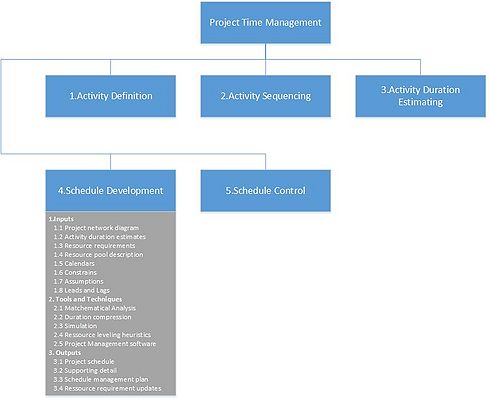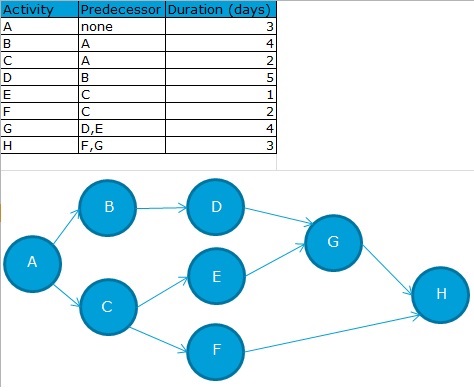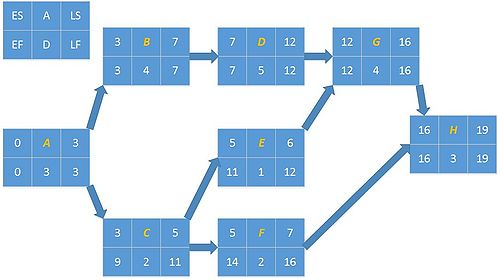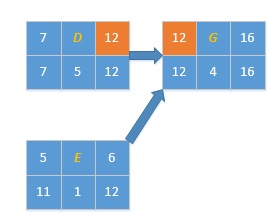Project Schedule Development
Developed by Radoslaw Tyczynski
Contents |
Abstract
Managing and organizing activities to achieve desired goals require a structured approach, as well as systematic and regularity. The article focuses on one of the segments of Time Management [glossary 1], namely project schedule development (PSD). It presents the importance of this aspect in terms of supporting project managers along with a project. It introduces the philosophy of scheduling and proposes a way of executing the mentioned segment.
Even though the process starts at an early stage, it is inseparable part and accompanies a project manager to an end of a project. Developing a high-quality schedule requires time, sufficient input, analyzing activities and resources [1]. In order to provide expected results, based on PMBOK@ Guide, technique and the methodology were presented, highlighting one of the methods: Critical Path Method (CPM). Proper application of tools leads to a fully developed schedule of all activities included in a project. Structured proceeding improves teamwork, communication and allows for better performing during a project life cycle [glossary 2]. A sequential plan helps in controlling and reaching previously established targets.
Motivation
There are many reasons behind project schedule development to be taken with appropriate caution while planning time frame of a project. First of all, it provides in structure way the scheme and toolkit for planned activities. Following the guidelines, it allows to build a sufficiently detailed plan of actions with the time-frame for each activity, enable tracking the progress and updating a schedule if necessary. Secondly, transparency and overview of planned action increase efficiency and support maintaining sufficient communication flow. More organized work often results in increased motivation, awareness of the project, as well as, gives a sense of stability among employees. At last but not least, PSD implemented correctly decreases the risk of delays, helps allocated resources, which may result in minimizing potential costs of the project.
Introduction
Project Time Management
Project Time Management (PTM) is defined as a set of processes with outputs to ensure all the activities throughout a project are accomplished on time[2]. It is about increasing efficiency, effectiveness and a control over time spent on particular tasks. As one of the key project management areas, PTM plays a major role in each out of five project phases. It reflects the overall performance during the project life cycle as well as the individual task consumption. “Control of time is competitive advantage”[[3], wisely used can increase benefits and decrease the costs of a project.

As it is shown in Figure 1. according to PMBOK, The Time Project Management consists of :
- Active Definition- defining particular tasks necessary to accomplished project's goals.
- Activity Sequencing- defining dependencies between project's tasks.
- Activity Duration Estimating- estimating the number of work periods that will be needed to execute an individual task.
- Schedule Development- evaluating the sequences of the tasks, its duration, and resources requirements in order to prepare the project schedule.
- Schedule Control- monitoring variations to the project schedule.
(different sources: PMI[5] divides it into 4 areas: Time Planning, Time Estimating, Time Scheduling and Time Control).
The overview is meant to be standardized for a general purpose of all project, however, based on a close connection between Activity Sequencing, Duration Estimating, and Development, they may be treated as one process, especially in small projects[2].
Schedule Development
As a project has starting and finishing date, so the project's activities should have them as well. It is essential to define a beginning and an end time of the individual work during a life cycle of the project in project management. Therefore, schedule development as one of the core processes in planning processes[6]should be proceeding with details and after analyzing key activities. With its nature to recognize realistic time and resources limitations, scheduling takes both into account while preparing the plan. Since the baseline of the schedule is affected by many factors while executing this process, PMs should have in mind that the procedure must be iterated.
The flow of Schedule Development is determined by the steps (see Figure 1.) :
- Project network diagram- a visual overview of the sequence and dependency(relation) between the activities.
- Activity duration estimates- estimating the number of work periods that will be needed to execute an individual task.
- Resource requirements- Quantity and type of resources required for each activity from Work Breakdown Structure (WBS)[glossary 3].
- Resource pool description- Quantitative and type availability of resources during a project.
- Calendars- Defining periods when work is allowed.
- Constraints- Limitations that affects project's teamwork.
- Assumptions- hypothesis and beliefs, which are taken for granted for the purpose of the project.
- Leads and Lags- Dependencies between predecessor and successor activities.
Inputs
- Mathematical Analysis- based on theoretical calculations of starts and finishes of the activities (without taking into consideration any constraints) it provides the time windows where particular activity should proceed. As most known methods include: Critical Path Method, PERT, GERT.
- Duration compression- Process used to shorten a duration of the activities without interfering with the scope of the project. Methods included in the process : Fast tracking and Crashing.
- Simulation- Based on assumptions multiple duration of the activities are calculated. One of the most known simulation is Monte Carlo Analysis.
- Resource leveling heuristics- based on resources constraints and limitation, start and end dates of the activities are adjusted.
- Project Management software- These products allows to speed up above calculation by automating the processes.
Tools and Technique
Outputs
Results of project schedule development are described in section Outputs of a project schedule development.
Application of Critical Path Method
Out of many tools to support schedule development, CPM was chosen for a wider description, based on its general simplicity[7] As the method is described in depth below, the theory behind the tool is not complicated and can be used in different kind of projects. Its relatively short time of updates and straightforward execution make this method suitable for beginners as well as more experienced project managers.
Critical Path Method
Critical Path Method (CPM)' is used as a tool for scheduling activities for executing projects. It allows determining activities with the highest impact on a project. These activities are called critical and it means, that they play such a role in a whole sequence of tasks that, their delay will cause a delay for the entire project. Therefore, defining CPM at the early stage and securing these activities to the possible extent, significantly decrease a risk of missing deadlines during a life of a project. In order to structure the method correctly, it is important to follow these steps below [8]

- List of activities: In terms of preparation of defining critical path, all activities included in a project must be listed. Next to activities detail information about its sequence and duration must be provided. An example-table is shown in Figure 2.
- Precedence Diagram: It is a visual representation of sequences. That diagram allows allocating each activity, showing clear relation between predecessor and successor. A sequence details are taken from a list of activities and respectfully presented in a diagram. See Figure 2 as an example.
- Active-on-node diagram:
Originally CPM was supported by PERT, but nowadays it was replaced by active-on-node diagram and PERT-like estimations are rarely used[10].
 Figure 3: Active-on-node diagram adapted from Engineering4free [9]
Figure 3: Active-on-node diagram adapted from Engineering4free [9]In the left-top corner, there is a legend that describes the content of each box in a node. Abbreviations meaning :
- A-Activity. In the boxes is marked as Orange letter and it defines particular activity with its details.
- D-Duration.
- ES - Earliest start, which is a value from Early Finish (EF) of the predecessor of that particular activity: EF of activity A is equal to 3, and activities B and C are its successors, so their ES is equal to 3.
- EF-Earliest Finish, which is sum of ES and D. ES+D=EF
- LS-Latest Start for particular activity.
- lF-Latest Finish, which is sum of LS and D. LS+D=LF
As a first step in executing the diagram, ES and EF are necessary to be calculated. For example, as it is shown in Figure 3., activity A has ES=0 and D=3, so EF=3+0=3. Then ES of activity B is 3, because EF of its predecessor is 3. When there is only one predecessor for the activity the methodology is straightforward and easy to follow. However, when activity has more than one predecessor, only one value of EF can be chosen. The rules say to choose greater EF of all options[11]. It is important regarding defining the longest path( See Figure 4.). A calculation is repeated till the last activity.
When calculation forward is completed, calculation backward may start. A procedure is very similar, but now starting activity is the last one in the project. EF of activity H becomes also LF of its activity, which means any delay in a project, postpone its ending. In terms of calculating LS, LF of H activity must be subtracted with D. LS=LF-D. Then, LS of the activity H becomes LF of predecessor activity. When there is only one successor to the activity the methodology is straightforward and easy to follow. However, when activity has more than one successor, only one value of LF can be chosen. The rules say to choose lower LF of all options[11].
- Define Critical Path: When all calculations are finished, critical path may be defined. Beginning from activity A, a critical path is the one with activities having EF=LF. From Figure 3. can be noticed that critical activities are: A, B, D, G, H. That equality results in no flexibility for these particular activities regarding time. If delay occurs in at least one of the tasks included in a path, a date of finishing a project is delayed as well. Activities not included in CP have so-called Float or Slack. Difference between LF and EF in these tasks shows an amount of time, a project can be delayed without affecting overall finishing date for a project. For example activities C : LT-EF= 11-5=6. If a delay happens during that task and it takes less then 6 days, a project is still finished on time.
Advantages of CMP
- CMP is easy to understand and to be explain. Readable and transparent layout make the diagram usable to anyone.
- Reading the diagram is intuitive and user-friendly. In a simply way presents dependency of tasks, making project easier to execute.
- The method highlights crucial activities for a project, and revile tasks were delays are acceptable (to some extent).
disadvantages of CMP
- CMP is not recommended for dynamic projects. Frequent changes require updating the schedule, where calculations may be time-consuming.
- CMP does not have a legend nor scale. Lack of information on the diagram requires additional documents in order collect relevant data.
Properly prepared CMP allows defining activities, which can have the biggest impact regarding time and highlights where PM's attention should focus on. Regardless of that, CMP does not include factors like resources availability or resources leveling. Additionally, time calculation is based on estimation and it may change the schedule. Luckily, the method stands out with its flexibility and ability to adjust, which make it a handy tool in PM's toolkit during schedule development.
Outputs of a schedule project development
Among the outputs of project schedule development, project schedule was chosen to be described wider. Key features and broad use of that result make it a valuable asset for project managers during a project life.
Project Schedule
A project schedule is a list of deliverables, targets, milestones, and activities, preferably with their dates of execution. It is built based on many related factors affecting the project. Designing a schedule resources allocation, task duration, budget, and task dependency are taken into account. That is why proper preparation of data and input factors (see figure 1.) are essential in order to establish a realistic project schedule. As the project schedule meant to reflect the actual status of the project it has to be updated. That kind of document is meant to be sensitive to the changes and all unplanned delays reschedule acceleration of operation should put on the plan. That can prevent confusion and decrease the number of future changes in the plan
Regarding medium and large size projects or project with high complexity, a preferable result is so-called Project Master Schedule. When it comes to manage and control all level tasks in projects it is important to have and general overview. Some deliverables require more activities and planning than others. Therefore, individual schedules focusing on a specific part of a project. Hence, PMS is a visual summary of key targets defined in a project[12]. Regardless, time and budget required preparing PMS, benefits for PM are undeniable. It allows efficiently coordinate tasks and supports maintaining on track with an overall schedule. It might be presented in many different forms, most common once
There are numerous tools, which may be found useful in visualizing task sequence and dependence among them. Choosing the suitable one depends on PM's preferences and features are to be highlighted. Few of most common once are briefly introduced below, based on PMBOK® Guide suggestion:
Project Network Diagram is a graphical illustration of tasks order and relations between them. It may present either a whole project or its part. A diagram should be readable for everyone, therefore it should be followed by a description of the shown sequences. WBS output is clearly visible while preparing diagram. PND is often confused with PERT Chart ( Program Evaluation and Review Technique), which is special kind of PND and proposed as one of the tools by PMBOK® Guide while building a project schedule. [13].
Gantt Chart is a bar chart presents what and when activities take place as well as how long it takes to finish the task according to a plan. Comparing to PND in Gantt charts user can spot overlaps in time of the activities. Utilization of that feature finds its usefulness in tracking parallelly executed tasks. Regarding the need, charts can be enriched with more detailed information, like task owner.
Milestone Charts display main deliverables during a life cycle of the project. Unlike Gantt charts, its only shows the exact date when the particular target should be achieved. Milestones are the result of accomplishment of certain activities in a certain period of time. Fulfilling milestones requirements is often treated as a performance measurement and reflects accuracy in executing a project regarding established schedule.
Time-scaled Network Diagram is a combination of network diagram and bar chart. That merger means that bar chart follows schedule network logic. As a result, activities on diagram based one their position and length reflect their duration. The difficulty of that method lays in the special manner of drawing a diagram.Thus, preparing the graph, description or short introduction is necessary for terms of common use and understanding.
Apart of mentions methods, PMs may find may others tools in their toolkit. Based on best practice in many companies methods are standardized and templates for the diagrams are prepared. That simplicity ensures common understanding and generality of the outputs, which are crucial for the communication flow inside projects in organizations.
Supporting details
That output gathers and sums supporting documentation for a project. Most of documentations differ respectively to a project e.g : cash flow projection, resources histogram, alternative schedules.The minimum requirement in supporting details is list of all assumptions and constrains related to a project.
Schedule management plan
Whenever changes are needed to be applied, the focus is on adhering to the former version of a schedule. Schedule management plan is a supportive document that can be qualified as a formal or informal item for the overall project schedule. it describes key indicators that are crucial in terms of managing the changes in the schedule and maintaining consistency in developing a new one.
Resources requirements update
As the necessary resources based on type and quantity were defined and allocated, it is important to keep on track with their current status. In many companies, the number of needed resources are represented as a number of working hours- a Full-Time Equivalent (FTE). For instance, when an activity is evaluated as 0.8 FTE weekly, it means that 29,6h (0,8*37 working hours a week) of Full Time Employee time is necessary to execute that task in given time. Thus, differences in accessibility of resources directly affect timetable of the project. Therefore, all the changes in an availability of resources are crucial to being updated and reflected on the activities schedule.
Limitation of PSD
The concept described above allows in clear and convenient way schedule the activities for a project, however as every process it has its weakness and limitations:
- Changing the scope: Activities defined before scheduling are based on the scope and subject matter expert analysis of the project in terms of delivering the desired deliverable. Nonetheless, it is unlikely that the scope remains the same through the whole life cycle of the project. Changing the scope means also defining new or re-defining existing activities, which in results affects the outputs out of Schedule Development.
- Decreased budget: For the Schedule Developments means that duration of some activities need to be shortened and resources reallocated.
- Since projects environment is dynamic and in constant change, there is no Schedule Development tool or method, which can build 100% accurate time-frame. Projects are affected and influenced by multiple factors, which ends up with readjusting or iterating the plan.
- Project Schedule development requires many factors as an input before executing the process. If listed inputs are prepared without sufficient both information, nor quality, outputs of PSD are likely to not accrue and iteration may be necessary.
- While building a schedule some of the activities may be never performed before, which means its duration and resources estimation is based partly on assumptions. These assumptions not always align in 100% with reality and at that point, regarding misalignment plan needs to be updated or iterated.
Glossary
- ↑ Time Management: One of the 12 project management's key areas of knowledge. Set of processes required to ensure executing a process withing agreed time.
- ↑ Project Life Cycle: A period of time with defined start and end date, when project is executed.
- ↑ Work Breakdown Structure: A deliverable- oriented set of project components, which are included in a project's scope .
References
- ↑ Page 31, 1996 ed. PMBOK® Guide
- ↑ 2.0 2.1 Page 59, 1996 ed. PMBOK® Guide
- ↑ https://www.pmi.org/learning/featured-topics/time. Retrieved 11 February 2018
- ↑ Page 60, 1996 ed. PMBOK® Guide
- ↑ https://www.pmi.org/learning/library/time-management-project-functions-schedules-5283. Retrieved 11 February 2018
- ↑ Page 47, 1996 ed. PMBOK® Guide
- ↑ Page 190, Dragan Z. Milosevic, Project Management ToolBox: Tools and Techniques for the Practicing Project Manager United States of America, 2003.
- ↑ https://web.archive.org/web/20100612142236/http://hspm.sph.sc.edu/COURSES/J716/CPM/CPM.html Retrieved 25 February 2018
- ↑ 9.0 9.1 https://www.engineer4free.com/4/how-to-draw-a-cpm-network-diagram. Retrieved 25 February 2018
- ↑ Page 67, 1996 ed. PMBOK® Guide
- ↑ 11.0 11.1 Fondahl, John W. "A non-computer approach to the critical path method for the construction". Stanford University. (1962).
- ↑ https://www.pmi.org/learning/library/fundamentals-master-scheduling-project-manager-1809. Retrieved 23 February 2018
- ↑ Page 64, 1996 ed. PMBOK® Guide
Bibliography
- William R. Duncan (1996): PMBOK® Guide (A Guide to The Project Management Body of Knowledge) provides guidelines in terms of project management. It covers all major aspect and introduces the essence of managing projects. Regarding project scheduling, it includes methodology, tools and key points to achieve high-quality outputs.
- PMI (Project Management Institute), an organization that defines worldwide standards for project management. Non-profit association gathering terminology, methodology, and certification related to project, program and portfolio management.
- Dragan Z. Milosevic, (Project Management ToolBox: Tools and Techniques for the Practicing Project Manager) United States of America, 2003. This book provides deep exploitation how and when particular tool from PM toolbox might be useful for executing projects.
